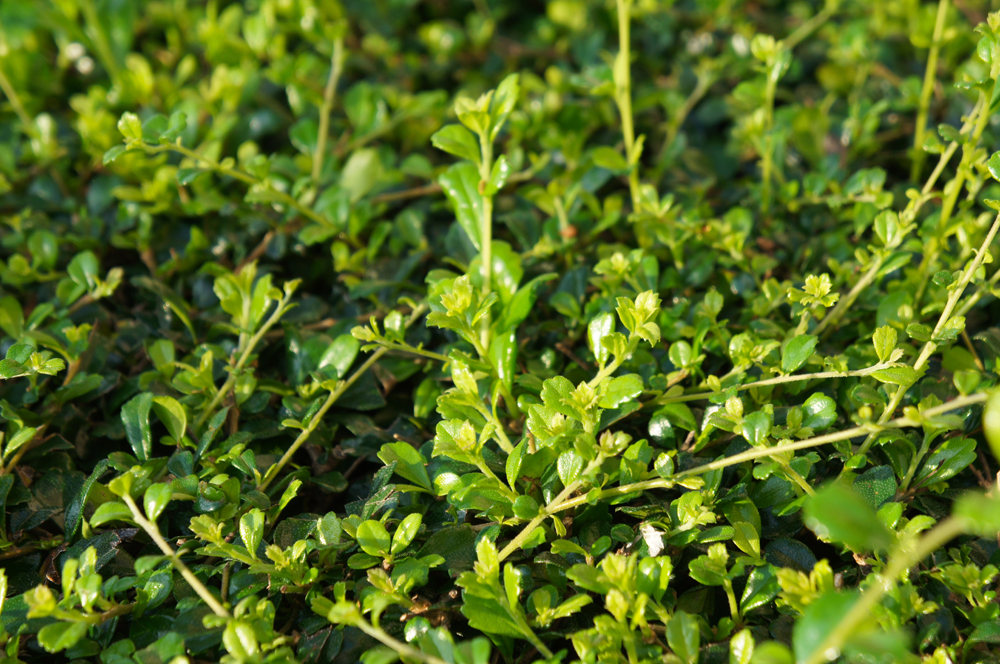Carmona microphylla or Ehretia microphylla
Common Name:
Fukien tea

General Information:
A very small genus of tropical tree which was once referred to (and still often listed as) Carmona. The most widely known Ehretia species is the Fukien tea, a tropical shrub originating in Southern China and other parts of Southeast Asia. It is very popular for bonsai in China, but not a traditional favourite in Japan. It can be grown outdoors in warm climates, but is quite popular as an indoor bonsai. Ehretia anacua, a recent addition to bonsai, is more resistant to heat and drafts.
Lighting:
Likes a bright position (1000 Lux). Most sources recommend only about an hour of direct sunlight daily, although success has been reported growing it in a sunny position all day.
Temperature:
Ehretia prefers temperatures between 60-72F in winter, although occasional dips into the forties produce no ill effects. In the summer, most books recommend protection from extreme heat, although the plant has been successfully grown in sweltering Texas weather. Ehretia does not like drafts.
Watering:
Keep well watered, reducing watering only slightly in winter. Never allow Ehretia to stand in water, or allow the soil to dry out completely. Frequent misting will discourage spider mites, but will apparently encourage mealy bugs. Choose your poison! Ehretia anacua, a Texas native, is more resistant to drafts, and likes to dry out a bit between waterings, but should not be allowed to become bone dry.
Feeding:
Every two weeks during growth, every four-six weeks in winter. Use bonsai food or half strength plant food. Do NOT use Miracid. Fukien tea does not like to be overfed; Lesniewicz suggests watering well before feeding to avoid root burn. Feeding weekly has been reported with success - I would guess that frequency of feeding can be increased as long as the strength of the food is kept diluted.
Pruning and wiring:
Prune new shoots after six to eight leaves have appeared. The leaves are tiny enough that leaf pruning should not be necessary. Can be wired any time during the growing season, but it is generally styled through pruning alone. Wire should not be left on over three months. Its small leaves and fine branch ramification make it ideal for miniature bonsai.
Ehretia anacua does not ramify as well, and its stiff branches make wiring dangerous. It has a strong tendency towards apical growth, and needs constant pinching of topmost branches. It buds back readily on old wood, and is suitable for any style, although broom and literati are especially nice.
Propagation:
By seed or softwood cuttings in spring or summer. Cuttings root more readily if given bottom heat.
Repotting:
Every 2-3 years, in early spring. Reduce water after root pruning. Bottom heat helps stimulate new root growth. Use basic soil mix.
Ehretia anacua is a faster grower than other Ehretia species, and may need yearly repotting in hot climates. It may be repotted spring-fall, but should be defoliated in the heat of summer. Beware of snapping thick roots - they are more brittle than they appear.
Pests and diseases:
Aphids, scale, chlorosis, mealy-bugs, snails. Red spider mites find this plant a special treat, and will attack it over any other plants in the area. Unfortunately, Fukien tea is very sensitive to insecticides, and Diazinon will kill the tree. Use the weakest insecticide possible that will address a particular problem, or if possible, employ predator insects. Will drop leaves if under-watered. Over-watering results in yellow, sickly leaves. It is quite sensitive to sudden changes in temperature and lighting. Ehretia anacua is more resistant to pests, with leaf miners being the only reported problem.
Some species suitable for bonsai:
Ehretia anacua - Rick describes this tree: 15 to 40 feet tall with a straight, fluted trunk having thick, furrowed dark brown bark. The leaves are rounded, dark green, and extremely rough, like sandpaper. The tree is listed as evergreen but colder temperatures will cause them to shed their 3” leaves. Depending on rainfall, the tree will flower, with clusters of white blooms, from early spring through late fall. The flowers are followed by yellow to red, two-seeded berries. Ehretia buxifolia (also called Carmona microphylla, Ehretia microphylla): Fukien tea, Philippine tea - Well loved for bonsai due to its tiny, shiny green leaves, tiny white flowers throughout the year, and red berries.
Ehretia dicksonii - a deciduous species of Ehretia. Rare as bonsai. Ehretia thrysiflora - Another deciduous species of Ehretia which deserves wider use in bonsai.
Bibliography:
“Bonsai Tips & Hints: The Works About Fukien Tea”, by Jean C. Smith, Florida Bonsai, VII, 2:45-47.
“Fukien Tea - A Tree Worth Knowing”, by Jean C. Smith, Florida Bonsai, XIV, 2:16 19
Ainsworth’s Art of Indoor Bonsai,” Jahn (ed.) “The Simon and Schuster Guide to Bonsai,” Lesniewicz’s “Bonsai in Your Home,” Owen’s “Bonsai Identifier,” the Samson’s “Creative Art of Bonsai,” and Tomlinson’s “Complete Book of Bonsai,” a post by Matthew Ward which compiled information he found on rec.arts.bonsai, and several posts by Rick from S-most Texas.
Compiled by Sabrina Caine and Thomas L. Zane
